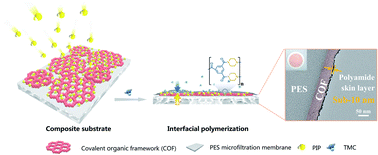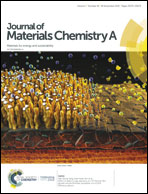Covalent organic framework-modulated interfacial polymerization for ultrathin desalination membranes†
Abstract
The demand for thin-film composite nanofiltration membranes bearing unprecedented water permeance and desirable salt rejection is ever increasing in desalination. Conventional interfacial polymerization usually generates a thick (∼100 nm) skin layer on hydrophobic substrate having low-porosity, leading to limited water permeance. Herein, we engineered a highly porous and superhydrophilic composite substrate to modulate the interfacial polymerization and generate an ultrathin polyamide skin layer, even below 10 nm. The composite substrate was constructed by depositing covalent organic framework nanosheets (CONs) on a microfiltration membrane via vacuum-assistant assembly. Owing to the highly porous structure and superhydrophilic nature of CONs, the composite substrate favored a high storage capacity and uniform distribution of the amine monomers. We manipulated the monomer storage capacity of the substrate by varying the loading content of CONs and demonstrated that higher amino monomer concentration could accelerate the self-sealing and self-termination of the interfacial polymerization, thus generating a thinner skin layer from ∼70 nm to sub-10 nm. Moreover, the highly porous structure of CONs imparted little additional water transport resistance. The sub-10 nm film composite membrane exhibited a superior water permeance of 535.5 L m−2 h−1 MPa−1 with a high rejection of 94.3% for Na2SO4, which was about 2–8 times higher than that of state-of-the-art nanofiltration membranes with comparable rejection.



 Please wait while we load your content...
Please wait while we load your content...